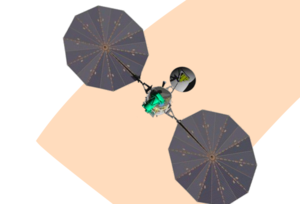Next Mars Orbiter
 The Mars 2022 telecomm orbiter concept features ion thrusters and improved solar arrays | |
| Names | Next Mars Orbiter (NeMO)[1] |
|---|---|
| Mission type | Telecommunications and reconnaissance |
| Operator | NASA |
| Mission duration | Planned: 6.5 years[1] |
| Spacecraft properties | |
| Launch mass | 1,900 kg (4,200 lb)[1] |
| Dry mass | 1,300 kg (2,900 lb)[1] |
| Payload mass | Instruments: 50 kg (110 lb)[1] |
| Power | 20 kW solar arrays[1] |
| Start of mission | |
| Launch date | Proposed: July 2022[1] |
| Rocket | Falcon 9 or Atlas V-411[1] |
| Mars orbiter | |
| Orbital insertion | September 2023[1] |
| Orbital parameters | |
| Periareion altitude | 320 km (200 mi)[1] |
| Inclination | 75°–93° (polar orbit) |
The Mars 2022 orbiter (Next Mars Orbiter, or NeMO) is a proposed NASA Mars communications satellite with high-resolution imaging payload and two solar-electric ion thrusters.[2][3]
The orbiter is proposed to be launched in September 2022 to link ground controllers with rovers and landers and extend mapping capabilities expected to be lost when the Mars Reconnaissance Orbiter and 2001 Mars Odyssey stop functioning.[2][1]
Features

Key features under study include solar electric ion drive engines, better solar arrays, and broadband laser communications (optic communication) between Earth and Mars.[2][3][4]
The orbiter is conceptually similar to the Mars Telecommunications Orbiter, canceled in 2005,[3] and could be a technology precursor for a future round-trip sample return mission and human expeditions to Mars.[2][5] Robert Lock is leading the concept studies for the 2022 orbiter.[2][5]
Concern in NASA is that the currently used relay satellites, 2001 Mars Odyssey and Mars Reconnaissance Orbiter, may stop functioning, resulting in the need to press the MAVEN science orbiter into use as a backup telecommunications relay.[2][3][6] However, the highly elliptical orbit of MAVEN will limit its usefulness as a relay for surface operations.[7][8]
Another suggested feature under study is "the sample rendezvous capture and return capability." The samples cached by the Mars 2020 rover would be placed in Mars orbit by a future Mars ascent vehicle. From there the orbiter would send the samples back to Earth.[9]
Propulsion
The proposed orbiter would be propelled with two solar-electric ion thrusters; one engine would be active while the other one would be a spare.[1] Electrical power to the engines would be provided by advanced solar arrays that generate 20 kW.[1]
An ion engine would give the spacecraft significant orbital flexibility for long-term support of future missions,[1] opportunistic flybys of Phobos and Deimos,[1] as well as the added capability of orbit support—rendezvous and capture—for a sample return mission.[1] An ion engine would also allow access to multiple latitudes and altitudes to optimize relay contacts.
Suggested payload
- Broadband laser communications (optic communication) between Earth and Mars[2][3][4]
- High resolution imager (30 cm/pixel)
- Potential for rendezvous and capture of soil samples
- Water ice detection and mapping[10]
- Potential for additional instruments from international partners
Status
NASA considers the Mars 2022 orbiter an "essential orbital support for sample return", "significant" in maintaining the Martian communications infrastructure, and desirable for the continuity in remote sensing.[11] The President's FY2017 Budget provides $10 million to begin early conceptual work on the proposed Mars orbiter.[11][12] In July 2016 the Jet Propulsion Laboratory awarded five $400,000[1] sub-contracts to conduct concept studies. The five engineering companies are Boeing, Lockheed Martin Space Systems, Northrop Grumman Aerospace Systems, Orbital ATK, and Space Systems/Loral.[13][14]
See also
References
- ^ a b c d e f g h i j k l m n o p q Jedrey, Thomas; Lock, Robert; Matsumoto, Mika (May 2, 2016). "Conceptual Studies for the Next Mars Orbiter (NeMO), Industry Day" (PDF). NASA/Jet Propulsion Laboratory.
- ^ a b c d e f g Stephen, Clark (March 3, 2015). "NASA eyes ion engines for Mars orbiter launching in 2022". Spaceflight Now. Retrieved March 7, 2015.
- ^ a b c d e Leone, Dan (February 24, 2015). "NASA Eyes New Mars Orbiter for 2022". Space News. Retrieved March 8, 2015.
- ^ a b Mei, Thuy, ed. (May 6, 2014). "Benefits of Optical Communications". NASA. Retrieved September 9, 2015.
- ^ a b Lock, R. E.; Bailey, Z. J.; Kowalkowski, T. D.; Nilsen, E. L.; Mattingly, R. L. (March 2014). Mars Sample Return Orbiter concepts using Solar Electric Propulsion for the post-Mars2020 decade. 2014 IEEE Aerospace Conference. March 1-8, 2014. Big Sky, Montana. doi:10.1109/AERO.2014.6836477.
- ^ NASA Eyes New Mars Orbiter for 2022. Astronaut March 9, 2015. Retrieved on September 9, 2015.
- ^ Stephen, Clark (July 27, 2014). "NASA considers commercial telecom satellites at Mars". Spaceflight Now. Retrieved September 23, 2014.
It is due to arrive at Mars in September, but MAVEN's planned orbit is not ideal for collecting and sending rover data.
- ^ Webster, Guy; Neal-Jones, Nancy (November 10, 2014). "Newest NASA Mars Orbiter Demonstrates Relay Prowess". NASA. 2014-389. Retrieved April 1, 2015.
- ^ Evans, Kim (October 13, 2015). "NASA Eyes Sample-Return Capability for Post-2020 Mars Orbiter". Denver Museum of Nature and Science. Retrieved November 10, 2015.
- ^ Clark, Stephen (July 27, 2016). "NASA developing plans for commercially-built Mars orbiter". Spaceflight Now. Retrieved July 28, 2016.
- ^ a b Watzin, Jim (March 9, 2016). NASA Mars Exploration Program Update to the Planetary Science Subcommittee (PDF). Update to the Planetary Science Subcommittee.
- ^ Brown, Dwayne; Cantillo, Laurie (April 21, 2016). "NASA Seeks Industry Ideas for an Advanced Mars Satellite". NASA.
- ^ "NASA Selects Five Mars Orbiter Concept Studies". NASA TV. July 8, 2016. Retrieved July 19, 2016.
- ^ Gearin, Conor (July 19, 2016). "Next-gen Mars orbiters to help human missions become more real". New Scientist. Retrieved July 19, 2016.



